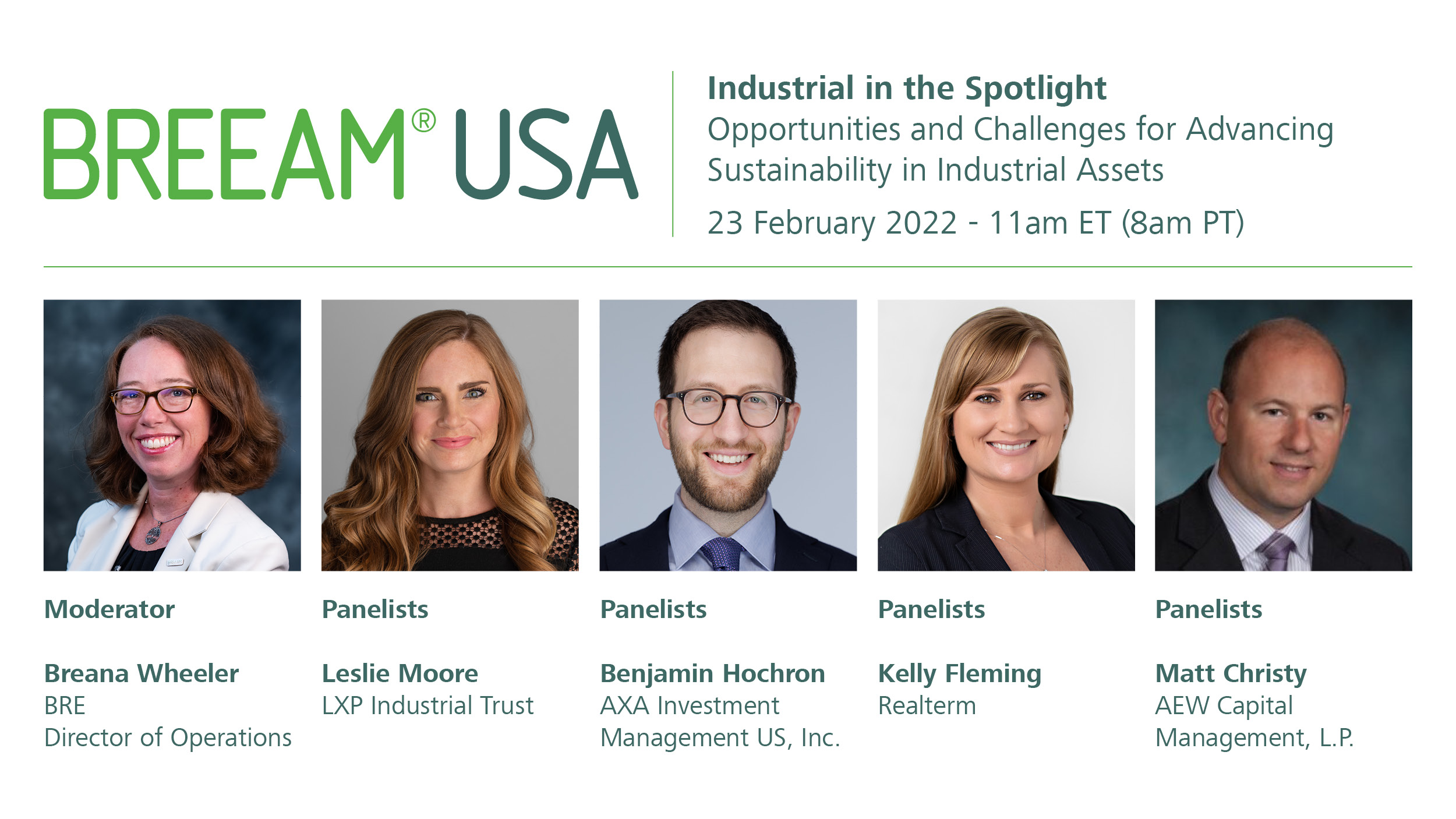Sustainability among industrial assets - BRE Group
Opportunities and challenges for sustainable industrial assets
The industrial sector has undergone a massive transformation in recent years as trends towards online retail, driven by the pandemic, have consequently fueled an increased demand for warehousing, logistics, and distribution space. Amidst this shift — which is expected to continue throughout 2022 — owners and operators in the industrial sector must rapidly improve the sustainable performance of assets to meet the tightening demands of the new stakeholders flooding the market.
This is a unique and complex issue — especially given that industrial assets are navigating both investor and tenant demand, while also actively working to prepare for looming global regulations. Remaining cognizant of data collection processes, ensuring the resilience of assets, and finding creative ways to implement renewable energy are key elements that will determine the successes of ESG strategies in the sector. In light of this, BREEAM recently invited experts from across the industrial sector to come together and discuss the challenges and opportunities for sustainable growth in this space.
Panelists included:
- Leslie Moore, Senior Vice President and Director of ESG & Corporate Operations at LXP Industrial Trust
- Benjamin Hochron, Vice President of Asset Management at AXA Investment Managers
- Kelly Fleming, Vice President of Corporate Sustainability and Operations at Realterm
- Matt Christy, Head of Architecture and Engineering, at AEW Capital Management, L.P.

The conversation — moderated by BRE’s US Director of Operations Breana Wheeler — was focused on exploring solutions to meet wider goals of net-zero carbon when building and maintaining resilient, healthy industrial developments. Keeping in mind the complicated and involved pathway to sustainable success in the sector, a number of unique considerations were brought to the table by our panelists, including:
The demand to improve the sustainable performance of industrial assets is coming from three directions: investors, tenants, and regulatory organizations.
“The pressure is coming from a few different places. Of course the investors, but equal pressure is coming from pending regulation in the US,” shared Benjamin Hochron. “As fiduciaries, we’re obligated to protect the value [of assets] when those [regulations] eventually arrive… You also see the price of carbon going up exponentially and more tenants raising questions about the sustainability of the buildings they occupy”
“LXP is mostly a triple-net REIT, so a lot of the time, the tenants operate and manage the buildings,” noted Leslie Moore. “There are a lot of sustainable initiatives going on, it’s just that the tenants are handling it. For us, we don’t see as much pressure from the tenants as we do the investors.”
“A lot of the demand is also coming from the end user — the consumer,” added Matt Christy. “They want to purchase products, services, and goods from companies that do have solid green footprints.”
Data collection is essential to achieving ESG goals, and connecting with a strategic partner is crucial when collecting quality data to ensure accuracy and accountability.
“Data is the absolute benchmark for your ESG sustainability program. If you don’t have good data, your reporting is going to reflect poor scores,” said Kelly Fleming. “I cannot stress enough the importance of an experienced third-party partner or internal staff who can collect that data… [Realterm is] enacting green lease language when we execute amendments, and that language allows us to bring our tenants to the table to discuss a sustainable plan and install things such as smart meters, so that we can collect consumption data without the concern of privacy issues. We want to make sure our tenants are on a sustainable path, willing to walk next to us in this journey, and provide that data needed for success.”
“One of the things we have been able to do is leverage consulting companies to access the data for us,” added Christy. “This has been a huge efficiency driver on our end, as we can access the data but we aren’t the ones processing or collecting it.”
To reach net-zero carbon in the industrial sector, it is imperative that property owners and operators implement renewables like solar — but creative solutions and constant communication with tenants is also required to achieve this goal.
“One would think it’s easy to install solar on top of buildings, but there are a lot of considerations and each market is different because of the cost of energy and local regulations,” shared Hochron. “You also have to consider the term of the tenant and the life of the roof… Out of a hundred buildings, it may only make sense for a handful. That needs to change because it’s such an important part of getting to net-zero.”
“In Europe, it might make more sense for us to install microturbines on some of our rooftops, or explore geothermal solutions as opposed to PV,” noted Fleming. “We’re taking a look at all of the options we have in terms of renewable energy. There are different solutions that make sense for different markets.”
“Specific to industrial, this is a challenge when it comes to terms. [LXP] has found lease terms are shortening, [which is both] landlord and tenant driven,” said Moore. “When it comes to tenant engagement, there are some things that make financial sense for the tenant and then certain things don’t — like if they have a five year lease and don’t know where they are going to be next.”
If you missed the webinar, you can view the recording here.
And if you want to hear more from BREEAM in the US and around the world, sign up for our newsletter to receive the latest news from our world-leading experts and alerts about upcoming webinars and events.
BREEAM USA news
Browse other BREEAM USA news

BREEAM USA's 2023 year in review: geographic and sector expansion drive robust certification growth

Investing in tomorrow: Unpacking the economic upside of ESG with BREEAM and J.P. Morgan

BREEAM USA certifications grow by nearly 160% in 2022

BREEAM announces partnership with EPA’s ENERGY STAR® program

BREEAM USA experts on the pathway to carbon net zero in real estate
Get in touch
Contact us now or call us on +14152981619 if you would like to talk to our team about how BREEAM can support you.
Return to BREEAM USA Homepage